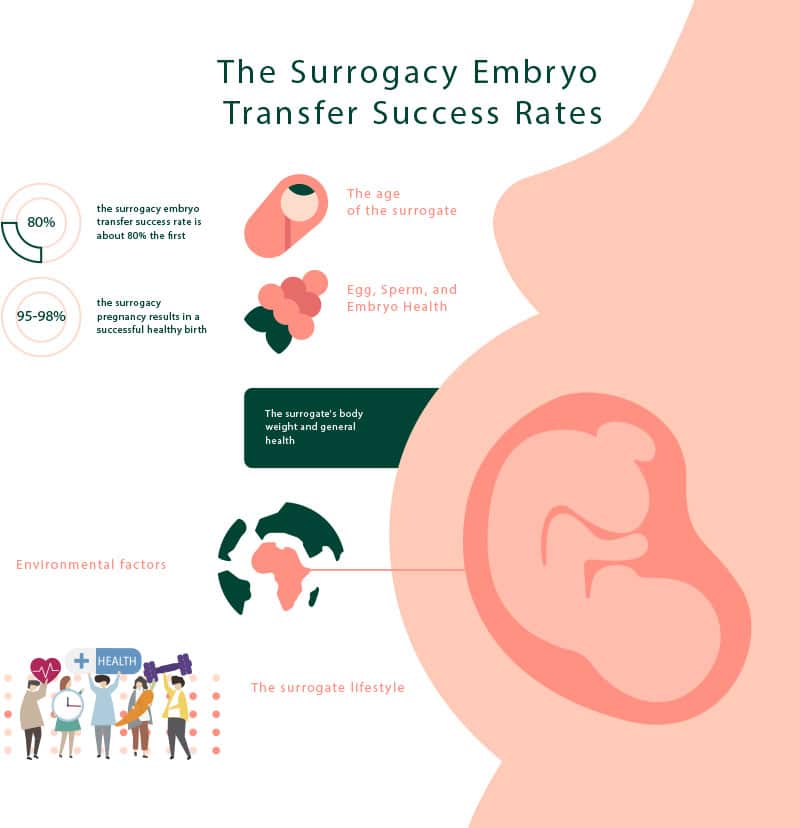For the surrogate mother and the the scheduled day of the embryo transfer is a big day on the surrogacy calendar. Assuming all goes well, this is one of the most important surrogacy steps in the entire surrogacy process. Why? This is the date and time that will technically be designated as the point of conception.
For surrogate mothers who are new to the surrogacy process in Philadelphia, this is the point when they might get a little nervous. It’s at this time when they will be asked to physically commit to carrying the child. It’s also the time when they are likely to have lots of questions about the surrogacy embryo transfer success rate and the surrogate implantation process.

To alleviate any concerns you might have regarding this most important step of the surrogacy steps, we would like to offer the following information.
Note: The overall process of the embryo transfer to surrogate mother might vary for each surrogate due to various circumstances, but you can use this information as a general guideline.
SURROGATE EMBRYO TRANSFER COST
Before we get started, we thought it would be prudent to mention the surrogate embryo transfer cost in Philadelphia. There is a very specific portion of the compensation package that is earned the moment the embryo transfer process is completed. As the gestational surrogate, you would be compensated in our clinic and upon completion. This is an exciting moment and your reward for giving of yourself and finally consummating the process.

PREPARING FOR EMBRYO TRANSFER
It’s imperative to get the process off to a good start. That usually requires making sure that the surrogate mother is comfortable and relaxed.
As the surrogate arrives at the clinic on embryo transfer day, they will need to fill out and sign paperwork. After dotting the Is and crossing the Ts, the surrogate mother is taken into one of the embryo transfer rooms where she will be made comfortable with a cooler temperature, soft lighting, and perhaps some soothing music playing in the background. If a surrogate would like a family member there for the procedure, that is usually permitted.
At some point, the embryologist (physician) will come in and be introduced. If they have any staff (ultrasonographic and or nurse)scheduled to assist them in the process, they too will be introduced. After the pleasantries and a complete explanation of the procedure, the physician will be able to determine the surrogate’s anxiety levels. If appropriate, the physician might prescribe a relaxation medication like Valium, which would also help to relax the muscles around the uterus. Note: the surrogate will need to be fully undressed from the waist down.
Just prior to beginning, a final ultrasound will be done to ensure everything in the surrogate’s womb is in good order. When the surrogate shows signs of being ready, the process can begin.
THE EMBRYO TRANSFER PROCEDURE

As the physician starts the embryo transfer to the surrogate mother, there is a very good chance there will be a monitor available that will allow the surrogate mother to watch the process. For some surrogates, being able to watch is both exciting and comforting.
The good news is the entire embryo transfer process happens in a matter of minutes. Many surrogates reference the procedure as being quite similar to a PAP smear in terms of how it feels.
After the physician inserts a catheter through the cervix into the surrogate’s uterus, the ultrasound will help guide the tip of the catheter to the ideal spot for implantation. Once that point is reached, the embryo or embryos are quickly passed through the catheter into the uterus and released in direct contact with the endometrium wall.
After the embryo or embryos have been released under monitoring with the ultrasound, the catheter is gently removed. A check will then be done via ultrasound to ensure all embryos have been successfully released. Assuming all embryos are accounted for, the procedure is deemed complete.
Note: If a surrogate was to experience any discomfort, it should be minor discomfort usually associated with having an object inserted into the vagina or having a full bladder. Physicians strongly suggest that a full bladder makes the process much easier to carry out.

For the most part, the surrogacy embryo transfer process is nothing more than a minor procedure. Aside from maybe a little bladder discomfort, there isn’t much stress put on the surrogate’s body in terms of pain, discomfort, or invasiveness. As was mentioned above, many surrogates equate the process with having a PAP smear.
For most surrogates, the most challenging part of the process is managing any nervousness and anxiety they might feel. As long as they express these feelings and concerns with the embryologist, medication can be offered to “take the edge off.”
WHAT TO EXPECT AFTER THE PROCEDURE?
After the procedure, there will be a wait of about two weeks before the pregnancy can be confirmed. The confirmation process is usually done with a blood test administered by the fertility clinic.
Right after the procurement, the surrogate mother will need to lay flat and relax for about an hour before being released by the physician. This is strictly a precautionary measure.
During the ensuing two-week waiting period, there could be a little bit of anxiety. That is why surrogates need to relax and make sure they get plenty of sleep. Eating a good diet is necessary as is strictly avoiding harmful substances like recreational drugs, tobacco, and alcohol. If by chance the embryologist prescribes any post-procedure medications, the surrogate should definitely follow the physician’s orders.
While resuming normal activities is definitely in the cards, the first 72 hours after the embryo transfer process should be devoted to rest and relaxation.
THE SURROGACY EMBRYO TRANSFER SUCCESS RATES
Due to the limited resources (egg and sperm cells) and cost concerns, embryologists aim to maintain a very high surrogacy embryo transfer success rate. To be clear, this number matters very much to both surrogates and intended parents.
The success of a surrogacy will be determined by several factors, including (but not limited to)
- The age of the surrogate (rate drops slightly for surrogates over 35)
- The surrogate’s body weight and general health
- The surrogate lifestyle
- Environmental factors
- Egg, Sperm, and Embryo Health

Assuming all of these criteria meet good standards, the surrogacy embryo transfer success rate is about 80% the first time. Once the pregnancy has been established, the surrogacy pregnancy results in a successful healthy birth about 95-98% of the time.
We hope this information serves you well and allows you to properly prepare for the surrogate implantation process. As you can see, there is very little if anything you should worry about. If you should have any further questions or concerns, you should get in direct contact with our surrogacy’s center administrative staff or your surrogacy representative. You are to be commended for taking part in such a giving gesture of kindness.
